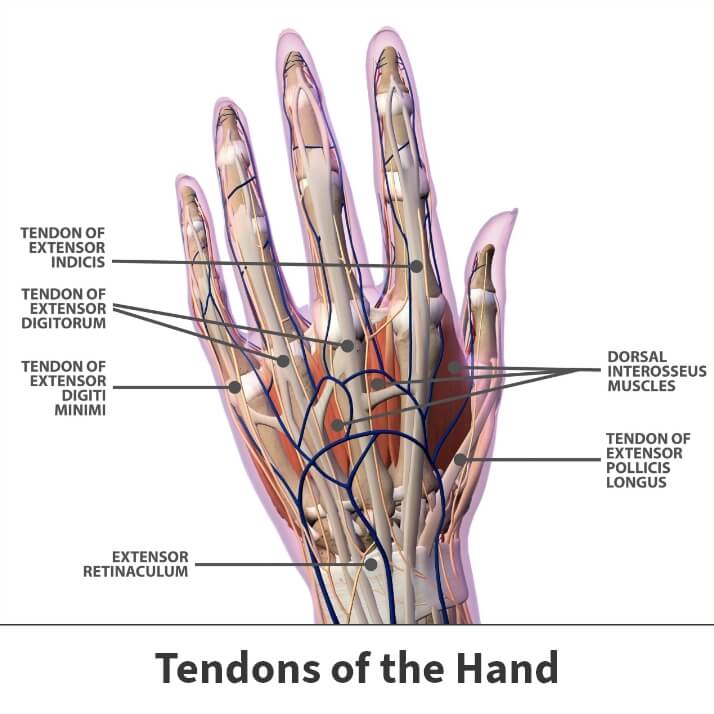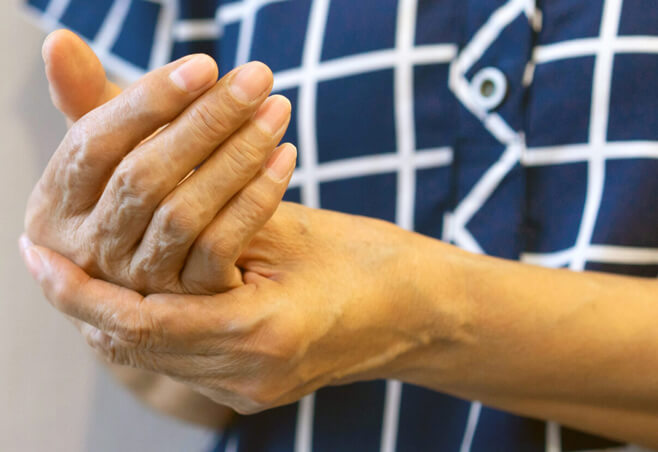Hand tendon transfers
Many people take their hands for granted. But these important body parts are essential to perform practically every large or small task. Your hands are made up of many important parts that help them carry out these functions. Among these parts are tendons. Serious tendon injuries can impact your hand’s ability to bend or possibly even move. A medical procedure called tendon transfers can be used to correct the problem.
Anatomy

Tendons are flexible pieces of tissue connecting bones to muscles. Your hands contain two specific tendons: flexor and extensor.
Flexor tendons begin in the flexor muscles of the forearms and extend to attach with the finger bones. Each finger contains two flexors, and the thumb has one. The flexors enable your fingers to bend. These tendons are close to the skin, which increases their chances of becoming injured.
The extensor tendon runs alongside the backside of your hands and fingers. These tissues attach the forearm muscles to your wrists. The extensors allow the fingers and wrists to straighten out. These tendons are also located not far beneath the skin, making them more prone to damage.
About
Tendon transfers are performed when one of your hand’s tendons sustain significant, movement-compromising injury.
Causes of tendon damage
The most common cause for tendon transfer surgery is a traumatic injury, such as an abrupt slashing or crushing. Events like car accidents, puncture wounds, or falls might bring forth such occurrences. Other possible factors include diseases, such as rheumatoid arthritis and certain autoimmune disorders.
There are four main causes of tendon damage:
- Nerve injuries – cut, stretched, or torn nerve
- Muscle injuries – trauma, rheumatoid arthritis
- Neuromuscular disorders – cerebral palsy, stroke, traumatic brain injuries, and spinal muscle atrophy
- Congenital disabilities – infants born without certain muscle functions

Symptoms
Symptoms and the severity of the occurrence will vary depending upon the specific location where the damage has taken place. You might have injured your flexor or extensor tendons if you experience problems, such as:
- Tenderness beneath an injured finger
- Swelling or redness in the damaged region
- Difficulty moving or bending injured fingers
- Discomfort when moving fingers
- In severe instances, complete immobility of one or more fingers
Injuries might also be present if there are wounds or cuts in areas surrounding the damaged tendon.
Diagnosing tendon injuries
If you show any of the preceding symptoms, your physician will ask if you recently injured your hand or have been previously diagnosed with illnesses, such as rheumatoid arthritis or some type of immune system disorder.
This will be followed by the administration of tests measuring your hand’s range of motion and flexibility. If symptoms are severe enough or your mobility is in any way compromised, your physician may order diagnostic tests, such as X-rays and magnetic resonance imaging (MRI scans). These diagnostic tests help provide images of your hand’s internal structures.
The procedure
Tendon transfers can be performed awake (under mild sedation) or asleep. This depends upon specific factors, like your age, general health, and the potential complexities or length of the surgery. During the tendon transfer procedure, your surgeon extracts a part of a healthy tendon and attaches it to the injured one. Once this process is complete, the incisions are closed and stitched.
Recovery
Your hand will likely be placed into either a cast or splint to promote healing and prevent it from contact. Typically, the area will remain immobile until the newly inserted tendon grows into its new position. This process usually takes anywhere from one to two months.
You may be required to undergo physical therapy, using special exercises designed to help restore your hand’s strength and mobility. Since overexertion can lead to re-injury, your exercise therapy must be performed in moderation.
Potential risks
When performed by an experienced surgeon in a suitable environment, risks are rare. But problems such as infections, excessive bleeding, and nerve damage are possible.
Videos
Related specialties
- Basal Joint Surgery
- Carpal Tunnel Syndrome
- De Quervain's Tenosynovitis
- Dislocated Finger
- Distal Radius Fracture (Broken Wrist)
- Dupuytren’s Disease
- Flexor Tendonitis
- Fractured Fingers
- Functional Nerve Transfers of the Hand
- Ganglion Cysts
- Hand & Finger Replantation
- Hand Nerve Decompression
- Hand Skin Grafts
- Nerve Pain
- Peripheral Nerve Surgery (Hand) Revision
- Revascularization of the Hand
- Rheumatoid Arthritis of the Hand
- Sports Wrist & Hand Injuries
- Sprained Wrist
- Sudden Acute Finger, Hand & Wrist Injuries
- Targeted Muscle Reinnervation (TMR)
- Thumb Ulnar Collateral Ligament Injuries
- Trigger Finger
- Ulnar Neuritis
- WALANT (Wide Awake Local Anesthesia No Tourniquet)
- Wrist Arthroscopy
- Wrist Fractures
- Wrist Tendonitis
